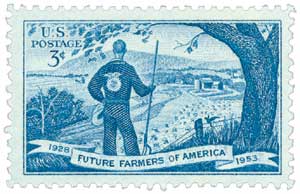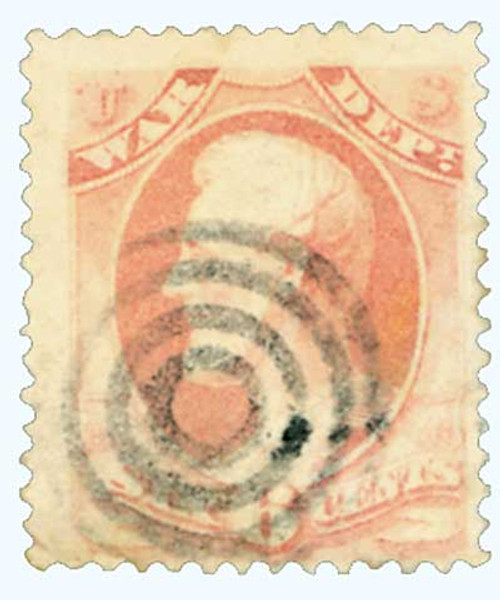
# O4 - 1873 6c Yellow, Department of Agriculture, Lincoln, Hard Paper
Â
1873 6¢ Lincoln
Official Stamp – Agriculture
Department of Agriculture

On February 9, 1889, the US Department of Agriculture attained cabinet-level status. The change was signed into law by President Grover Cleveland.
The United States Department of Agriculture, commonly called the USDA, has its roots in the patent office. In 1837, lawyer Henry Leavitt Ellsworth became the commissioner of patents and sought a way to improve crops and livestock in America. He began collecting and distributing seeds and plants to the rural communities through congressmen and agriculture societies. For his foundational work, Ellsworth is called “The Father of the Department of Agriculture.â€

The earliest incarnation of the Department of Agriculture was established in 1839 as the Agricultural Division of the Patent Office. A decade later, the Patent Office was transferred to the new Department of Interior. Over the next few years, calls were made to establish a separate bureau of agriculture.

On May 15, 1862, President Abraham Lincoln approved the Department of Agriculture, led by a commissioner without Cabinet status. Lincoln described the new department as the “people’s department.â€Â At the time, about half the country’s population lived on farms. In the following decades, farmers and advocacy groups lobbied for the Department of Agriculture to get Cabinet rank.

The House of Representatives and Senate passed bills in 1887 giving the Department of Agriculture Cabinet status, but was dropped by a conference committee after farmers objected to the addition of labor. Then, on February 9, 1889, President Grover Cleveland signed legislation elevating the department to Cabinet level.

The Smith-Lever Act of 1914 established another important service of this department. Cooperative extension offices are now in most rural counties of the US to provide education in agriculture and home economics. Other programs directed by the USDA are 4-H and the Future Farmers of America (FFA), as well as support for colleges involved in agricultural research.

American farmers are often so successful at producing crops there is often a surplus. The Department of Agriculture oversees food distribution programs in the US, such as free and reduced lunch and supplying food to low-income and homeless families each month. Overseas programs provide relief to developing countries and those recovering from disasters.

Today, the Department of Agriculture oversees the development and implementation of federal government policy on farming, agriculture, and food. It also works with farmers and ranchers to promote agricultural trade and production, ensure food safety, protect natural resources, assist rural communities, and put an end to hunger in America and around the world.
Â
Â
1873 6¢ Lincoln
Official Stamp – Agriculture
Department of Agriculture

On February 9, 1889, the US Department of Agriculture attained cabinet-level status. The change was signed into law by President Grover Cleveland.
The United States Department of Agriculture, commonly called the USDA, has its roots in the patent office. In 1837, lawyer Henry Leavitt Ellsworth became the commissioner of patents and sought a way to improve crops and livestock in America. He began collecting and distributing seeds and plants to the rural communities through congressmen and agriculture societies. For his foundational work, Ellsworth is called “The Father of the Department of Agriculture.â€

The earliest incarnation of the Department of Agriculture was established in 1839 as the Agricultural Division of the Patent Office. A decade later, the Patent Office was transferred to the new Department of Interior. Over the next few years, calls were made to establish a separate bureau of agriculture.

On May 15, 1862, President Abraham Lincoln approved the Department of Agriculture, led by a commissioner without Cabinet status. Lincoln described the new department as the “people’s department.â€Â At the time, about half the country’s population lived on farms. In the following decades, farmers and advocacy groups lobbied for the Department of Agriculture to get Cabinet rank.

The House of Representatives and Senate passed bills in 1887 giving the Department of Agriculture Cabinet status, but was dropped by a conference committee after farmers objected to the addition of labor. Then, on February 9, 1889, President Grover Cleveland signed legislation elevating the department to Cabinet level.

The Smith-Lever Act of 1914 established another important service of this department. Cooperative extension offices are now in most rural counties of the US to provide education in agriculture and home economics. Other programs directed by the USDA are 4-H and the Future Farmers of America (FFA), as well as support for colleges involved in agricultural research.

American farmers are often so successful at producing crops there is often a surplus. The Department of Agriculture oversees food distribution programs in the US, such as free and reduced lunch and supplying food to low-income and homeless families each month. Overseas programs provide relief to developing countries and those recovering from disasters.

Today, the Department of Agriculture oversees the development and implementation of federal government policy on farming, agriculture, and food. It also works with farmers and ranchers to promote agricultural trade and production, ensure food safety, protect natural resources, assist rural communities, and put an end to hunger in America and around the world.
Â













